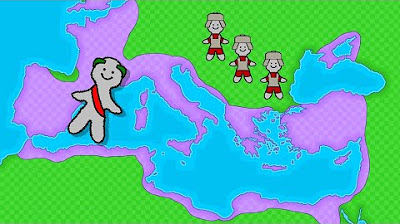A History of Roman Art
Summary
TLDRRoman art, spanning from 753 BC to 476 AD, showcases the influence of Greek and Etruscan styles while contributing uniquely to visual arts. Notable forms include realistic sculpture, monumental architecture like the Colosseum and Pantheon, intricate mosaics, and vibrant frescoes found in Pompeii. Roman coins served as propaganda, featuring detailed portraits of emperors. This diverse artistic legacy significantly shaped Western artistic traditions for centuries, reflecting the sophistication and creativity of ancient Roman society.
Takeaways
- 🏛️ Roman art spans from the founding of Rome in 753 BC to the fall of the Western Roman Empire in 476 AD.
- 🎨 Roman art was heavily influenced by Greek, Etruscan, and other ancient civilizations.
- 🗿 Roman sculpture is known for realistic portraits, mythological scenes, and decorative reliefs.
- ⚒️ Monumental sculptures like the Colossus of Rhodes highlight Roman sculptors' skills.
- 🏗️ Roman architecture features iconic structures such as the Colosseum, Pantheon, and aqueducts.
- 🔨 Romans innovatively used concrete for complex vaulted ceilings and arches.
- 🖼️ Roman mosaics are intricate artworks made from colored glass or stone, often used in flooring and walls.
- 🖌️ Although much of Roman painting is lost, frescoes from sites like Pompeii depict various subjects.
- 💰 Roman coins served as propaganda, showcasing the emperor and significant events with detailed designs.
- 🌍 Overall, Roman art was diverse and has had a lasting influence on Western European artistic traditions.
Q & A
What time period does Roman art cover?
-Roman art spans from the founding of Rome in 753 BC to the fall of the Western Roman Empire in 476 AD.
Which civilizations influenced Roman art?
-Roman art was greatly influenced by the art of the Greeks, Etruscans, and other ancient civilizations.
What are some notable forms of Roman art?
-Notable forms of Roman art include sculpture, architecture, mosaics, painting, and coins.
What is a significant feature of Roman sculpture?
-Roman sculptors were known for creating realistic portraits and mythological scenes, often in marble and bronze.
Can you name an example of monumental sculpture from Roman art?
-The Colossus of Rhodes is an example of monumental sculpture that showcases Roman skill.
What architectural achievements are attributed to the Romans?
-The Romans built impressive structures like the Coliseum, the Pantheon, and aqueducts.
How did the Romans innovate in architecture?
-They were skilled in using concrete to create complex vaulted ceilings and arches.
What materials were used in Roman mosaics?
-Roman mosaics were made from small pieces of colored glass or stone arranged to form intricate patterns and scenes.
What subjects did Roman frescoes typically depict?
-Roman frescoes depicted a range of subjects including mythological scenes, landscapes, and still lifes.
How did Roman coins serve a purpose beyond currency?
-Roman coins were an important form of propaganda, used to disseminate images of the emperor and significant events.
Outlines

This section is available to paid users only. Please upgrade to access this part.
Upgrade NowMindmap

This section is available to paid users only. Please upgrade to access this part.
Upgrade NowKeywords

This section is available to paid users only. Please upgrade to access this part.
Upgrade NowHighlights

This section is available to paid users only. Please upgrade to access this part.
Upgrade NowTranscripts

This section is available to paid users only. Please upgrade to access this part.
Upgrade Now5.0 / 5 (0 votes)





